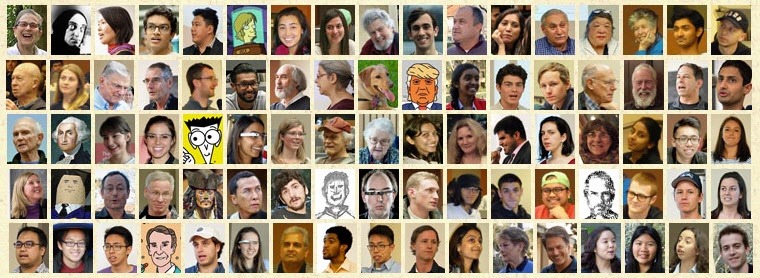| |
|
|

|
|
ATLAS |
|
|
Assistive
Technology
Laboratory
at
Stanford |
|
|
|
Technology
and design benefitting individuals with disabilities and older adults in the
local community |
August 9, 2018 |
|
|
|
|

Perspectives is the newsletter of the
Stanford course,
Perspectives in Assistive
Technology.
Problem Statement Format for
Student Project Suggestions
This issue introduces the Problem Statement Format for student
project suggestions.
|
Perspectives in Assistive Technology is a Winter
Quarter Stanford course - preparing for its thirteenth year - that
explores the design, development, and use of assistive technology that benefits
people with disabilities and older adults. It consists of semi-weekly classroom
discussions; lectures by notable professionals, clinicians, and
assistive technology users; tours of local medical, clinical, and
engineering facilities; student project presentations and demonstrations; an
assistive technology faire; and a film screening. |
This course relies on your involvement,
so please suggest a
project based upon an identified problem or challenge.
Introduction to Student
Projects
Previous newsletters described the
benefits & process, requirements, and recommended activities for submitting a student
project suggestion. This issue intoduces the Problem Statement Format for
describing a candidate student project.
Project Statement
Format
What happens after
a project suggestion is submitted? - Submitted project suggestions
will be read, reviewed, and considered. Those that meet all the project
requirements and receive my approval will be accepted as candidate team
projects. A project Problem Statement describing the challenge will be
composed for posting on the course website and disseminated as a handout to
students on the first day of class. Refer to
this past year's team candidate project
list for examples of past Problem Statements.
The Problem
Statement consists of these short paragraphs:
Name -
a simple, short, descriptive phrase or title to refer to the
project.
Background
- an overview of the organization and / or provide a general description of
the population addressed by the project suggestion.
Problem
- a brief and concise description of the problem, including how it affects
the particular person with a disability or older adult. (The
Everyday Usefulness of the Problem Statement by Alan Nicol is a
well-written reference article.)
Aim - a
description of what the proposed solution should do, but
not how it should do it.
Design
Criteria - a list of the desirable operational features and
characteristics of the proposed solution. Priortize the criteria into those
that are essential, those that would be good to include, and those of lesser
importance.
Other -
additional information that will illuminate the problem and facilitate a
solution, such as photographs, short videos, a list available resources,
weblinks, and general design suggestions.
Contact
Information - the suggestor's name, company (if applicable), email
address, and phone number (optional).
Review of Project
Solicitation Process and Activities
Briefly, what is
the process for considering and submitting project suggestions? -
First identify a specific challenge or problem experienced by a person with a
disability or older adult. Then perform an internet search to confirm that the
problem has not already been adequately addressed. Then carefully review the
project requirements to make
sure the idea complies with all the criteria. Finally submit a short email -
text format is ok - that identifies the user or population affected and briefly
describes the nature of the problem. Include desirable features of a solution,
but do not specify how the device should appear, be built, or solve the problem
- as those are tasks for the student team to consider. It is ok if the problem
affects just one individual. Refer to the current candidate project list as a
guide.
Project Suggestion
Submission Deadline
What is the
deadline for submitting project suggestions? - Please email
suggestions to me as soon as possible so I have adequate time to consider all
submissions, edit approved entries, and post them - not later than Saturday,
December 1st. Feel free to contact me before the deadline to discuss your ideas
and suggestions.
Opportunity to
Learn about Powered Clothing

Learn about Powered Clothing
The
Avenidas
Generations Lab is recruiting older adults to provide input to improve
Seismic's line of powered
clothing.
Seismic is an apparel company, located in Menlo Park, that seeks to
transform people's relationship with clothing that enhances one's ability to
move through life. Their goal is to shape human potential through a new
integration of apparel and robotics called Powered Clothing™. Powered
Clothing™ enables everyone - from older adults to athletes to people with
a wide range of physical disabilities - to achieve their full mobility
potential.
To
learn more, schedule a one-hour appointment through Avenidas with Eric Gee by
email or phoning him at
650/289-5409.
Older
adults will be paid $25 to attend an initial orientation and selected
individuals will be paid for each hour of future participation.
The
initial orientation includes:
- Watching a
video that introduces Seismic and Powered Clothing™
- Learning about
enrollment opportunities for Seismic's user testing program
- Be measured
and fitted for a Seismic garment (selected individuals)
Ideal
Powered Clothing™ users are those who:
- Experience
difficulty with activities such as standing up from a seated position, climbing
stairs, bending, etc
- Are active,
engaged individuals
- Have a body
mass index (BMI) less than 30
|
|
Upcoming Local
Event

Inclusive Housing Community Advocacy
Workshops
The
Kelsey seeks to develop a solution for the disability housing crisis in the
Bay Area that is financially sustainable, rooted in partnership, built for
scale, and fully inclusive. It is envisioned to consist of mixed ability, mixed
income housing communities where people of all abilities and backgrounds live,
play, and serve together. The Kelsey team is working to unlock new capital for
disability and affordable housing; leveraging existing public, private, and
nonprofit partners; and creating housing models that are sustainable and
replicable.
Lindsay Johnson, Director of Policy and
Partnerships, reports, "The Kelsey recently received a grant from the
Chan Zuckerberg Initiative to
conduct an eight-month organizing and pre-development process to design,
enable, and build inclusive communities. Part of this process includes engaging
diverse local stakeholder teams to work towards new solutions. We would love to
have community members of Stanford's Perspectives in Assistive Technology
course who have an interest in disability or housing advocacy join our Silicon
Valley team. Your attendance and participation is invited at our next workshop
meeting in August. Please feel free to reach out to me at any time with your
questions."
|
|
Email questions, comments, or
suggestions - Please email
me if you have general questions, comments, or suggestions regarding the
course. Thank you again for your interest.
Dave
|

To unsubscribe from this newsletter, please email
Dave. |
|





